So you want to get a housing! There's a lot to take in at first glance, so here's a quick list of things that might bite you.
I recently purchased a second-hand Nimar NID5300 for my Nikon D5300. After five years of smooth diving with a Nauticam housing for a Sony RX100IV (the NA-RX100IV), maybe I'm spoiled, but the Nimar so far has caused me nothing but trouble. This page is a rant about housing design in general, using my Nimar as an exemplar.
Avoid housings with face-plate clasps and single-screw arms, and factor in extra-but-really-required addons like vacuum pumps and ball mounts.
If this article has an intended audience, it's for folks building and buying housings. In the former
case, please make very clear what your housing needs to operate. In the latter case, read carefully to
see which of those add-ons
are really necessary.
missed connections
This regards optical strobes—those using fiber-optic cables.
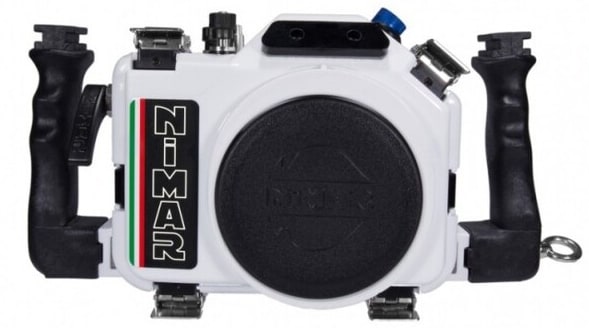
Do you see the little black bar at the top of the housing? It has two holes that look like fiberoptic slots, so it looks like you can just pop the internal flash and sync with your strobes like with my prior Nauticam or my Easydive. And the product literature clearly states that you can use the internal flash.
I can pop the internal flash in the Nimar housing, but there's no way out-of-the-box to connect external strobes to their signal. That little black bar is completely ornamental. Great.
You can only use strobes if you buy the flash trigger, which comes with a clear bulkhead port. Without the clear bulkhead port, there's nowhere to connect your cables. So to use my strobes at all, I need to buy the flash trigger even if I don't need a flash trigger.
For internal flashes, make sure that there's a documented way to carry signal to your strobes.
Another annoyance of the Nimar is that it only has a single bulkhead for strobes. This means I need to attach the strobes to each other with a cable that stretches between the two — this poses an entanglement hazard — or buy yet another cable device to split the signal into two.
Have your strobe bulkhead contain two ports for connecting strobes.
Lastly, remember that there are fiberoptic cables, and there are fiberoptic cables. Some can carry the signal from an electronic trigger, some can't. I have no idea how to differentiate.
in these arms
In many housings, the housing arms are part of a separate tray that screws in to the base in several places. For example, despite being expensive, I liked my Nauticam tray because it attached both to the housing base and also to the side of the housing, making the arms sturdy and stable.
In other housings, the arms are integrated into the housing itself. Which is fine, unless they're shabby in quality.
Make sure that integrated arms attach at multiple points and won't loosen or break when twisted. But better yet — make the arms modular so we can use our own.
In my Nimar (I see this in some Ikelite models as well), the arms are integrated and screw in directly
at the point of rotation. The left-hand arm is attached (at the rotation point) with an external screw
that has an eye-hole. It's secured
by a groove that prevents
free rotation.
Unfortunately, the screw has a tendency to loosen, and when it does, the left arm can rotate and even
detach.
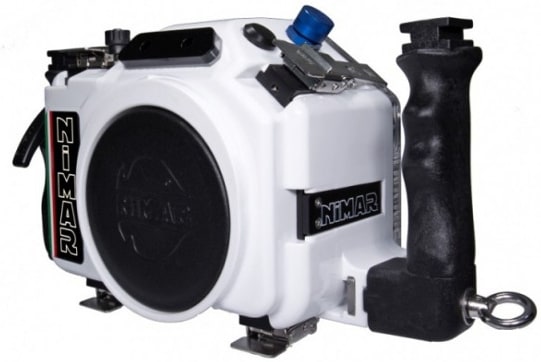
Two separate dives have featured a detaching left arm. Don't think you can reattach easily: if the washer comes off, the screw is too long and will leave the arm spinning around. Furthermore, that eye-hole looks like you can attach that to a double-ender—very convenient! Don't: unless you have a swivel, putting torque on the eye-hole will cause the screw to unscrew even faster.
No problems yet with the right arm, which attaches with a slightly more sturdy hex screw, except that it wobbles a bit. So maybe I should add emphasis: no problems yet, because a wobble in time produces breakage.
Next, and this applies to both integrated and external trays, is to make sure that your tray connects to both your housing (if external) and existing accessories. Most external accessories connect with the standard underwater 1" ball mount.
Factor in that you'll need to buy special
ball-mount adapters to connect the arms to anything
useful.
Most tray/housing companies are guilty of a cash grab by requiring a special ball mount adapter. After all: why bundle something useful when you can sell it for extra?
Lastly, the Nimar's
terminal slide attaches by sliding onto the arm and being secured
with an external
screw.
Your ball mounts should remain attached and be strong enough to handle strobes, video lights, and so on. Ideally they should attach directly to the tray or housing with a screw.
As for the Nimar's terminal slide — yes, it loosens. Yes, it did loosen. Yes, it took with it my strobe. (I got it back.) Please remember that a weak connection will wait until your dive's critical points to come undone.
unstable relationships
One slightly non-standard, but not exactly rare, tool for underwater photography is the tripod. As a lemma, if your camera supports it, so should the housing. So make sure that your housing has a ¼" screw for a standard tripod or factor in a ball mount for both your tripod and housing base.
Anticipate long-exposure photography with a tripod—that is, make sure that your housing has a ¼" screw mount possible.
I'm switching to use ball mount under the housing so that I can attach to both a tripod and scooter, but that's another story.
face-palmplate clasps
My Nimar has flooded more than once not because of hairs in the o-rings or cracks in the plastic, but because the housing warps and depth and the clasps connecting faceplate to housing came undone.
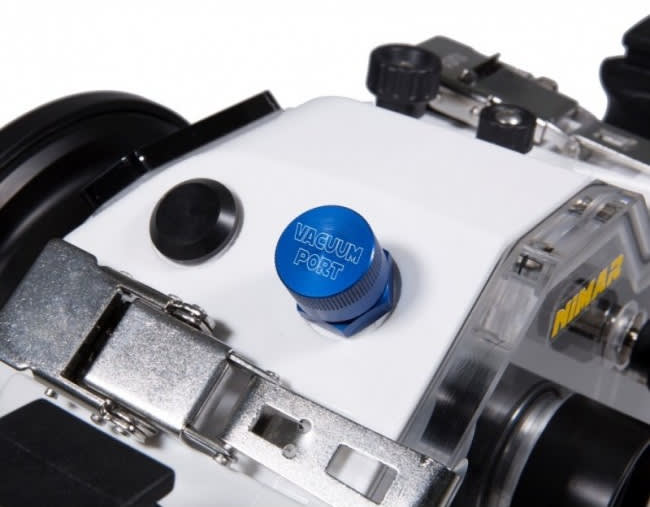
The face-plate is affixed to the housing by four metal clasps. The clasps open by pressing a metal tongue and lifting. The burden is upon you to make sure that nothing applies pressure to those clasps in the right way, such as your stages, hoses, etc., etc.
If it opens, your housing will flood. Game over.
If the face-plate clasps are easy to open, they'll open. If any one clasp catches on something and there's pressure on the tongue: game over. If your housing warps at all, and the clasps don't lock, they can lift away.
I know that some Ikelite housings have the same construction. Even expensive housings, like the EasyDive family, use clasps. On the Nauticam (and the Fantasea, I think), the housing face-plate is hinged and locks with a swivel lock. This is much safer, as opening requires a jointed operation.
There are numerous other problems with the Nimar's clasp design. For example, when setting the housing down, the ground is touching the clasps. I'm 100% sure that someday I'm going to set the housing down prior to a dive, something will depress a tongue and loosen the clasp, and it'll come off when I enter the water. (Not even to mention that this can damage the clasps themselves.)
There are trivial ways to fix this, such as having the clasps lie in grooves (this would also allow room for a tripod mount, or screw mounts for external trays. Some of the EasyDive housings, for instance, only have clasps at the top and hinge the faceplate.
vacuums and floods
Vacuum pre-testing is an absolute necessity that seems optional until you have a hair in your o-rings and a tiny bit of water seeps in, bit by bit, where early detection would have saved your rig. Remember: it's not if you have a leak, it's when.
Make sure there's a way to test your moisture sensor's battery; or better yet, to test that the moisture sensor in general is functional.
Make sure that the sensor itself is at the bottom of your housing, where water will accumulate before reaching your camera and lens!
Most housings sell optional vacuum equipment. You will need it, however.
Like most underwater photographers, I'm addicted to vacuum detection. I'll usually engage the detector prior once when preparing the kit, then again when to travelling to the dive site. In the first case, I can recover and find out what caused the issue. In the second, I can scrub my dive if there's a problem (if not fix it on-site).
button-on, button-off
This is a problem that only reveals itself with time: button construction. This only applies to housings with mechanical buttons. On the Nimar, I'm not even sure why they bothered putting push-button controls: they aren't aligned properly and each one is stuck. There's also no way to take these buttons out and clean them off, which should be a standard procedure.
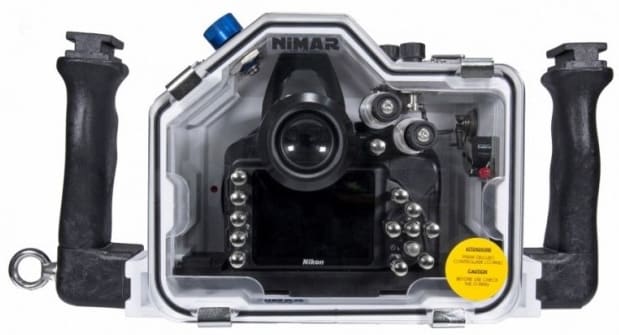
Push-buttons are used for mucking around with settings in the water. Usually you won't do this, and only use the dials for changing aperture and shutter. The only time I need to use the push-buttons in the water is to change ISO, which happens rarely.
Getting these buttons to line up and depress under pressure requires careful machining.
Anything spring-loaded (buttons, some levers) eventually sticks. Wheels and gear-based levers are more reliable.
There's nothing you can do to check for dodgy buttons beyond using the housing, but you can assume that anything with a spring will fail first. This is a problem with most any housing with mechanical buttons, but I didn't expect it to happen so soon.
Make sure you can map all important interfaces (shutter, critical settings, zoom) are reachable by the
main
levers and gears. No small push-buttons!
If any buttons stick at all when you purchase the unit, send it back immediately! They'll just get worse.
a cog in the wheel
I usually dive with wet lenses on a flat port. Switching wet lenses requires zooming: out for
wide-angle, in for macro. So zoom lens housing ports come with a zoom gear
that does this.
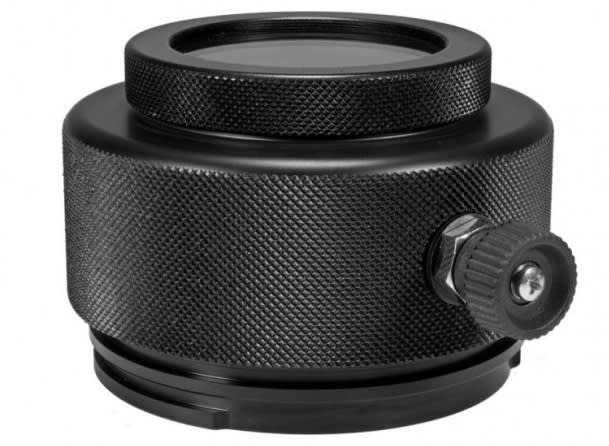
It's usually a toothed gear, rotated on the outside of the lens, that catches on the lens zoom ring and moves it. On the Nimar, the teeth catch on to a toothed sleeve atttached to the camera lens itself.
Of the dozen or two dives with the Nimar, three times has the zoom gear detached while entering the water. This basically means shooting at whatever zoom focal length was last used before being dislodged.
Make sure your zoom gear always catches
the sleeve. And if it does, that it doesn't necessarily
dislodge if jostled. Once dislodged—no more zoom.
Like with dodgy buttons, I'm not sure how to check for this before purchasing. I'm always careful to make sure zoom works before sealing the housing, but all it takes is a giant stride entrance to dislodge the gear again.